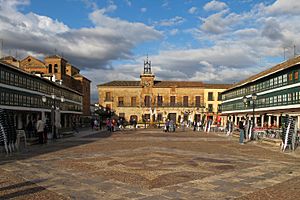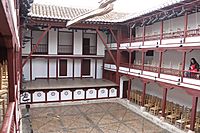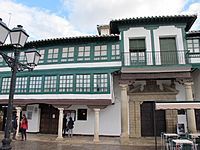Corral de comedias de Almagro facts for kids
The Corral de Comedias de Almagro is a very old and special theatre located in the main square (Plaza Mayor) of Almagro, a town in Castile-La Mancha, Spain. It's the best example of a 17th-century open-air theatre that is still standing today.
This amazing theatre was rediscovered in 1953 when the Plaza Mayor was being updated. It officially reopened on May 29, 1954, with a play by a famous writer named Calderon de la Barca. Today, the theatre is home to the Festival Internacional de Teatro Clásico (International Classical Theatre Festival), which takes place every year.
Contents
History of the Almagro Theatre
How the Theatre Started
This special theatre, called a "corral de comedias," was first built inside an old inn. It was located on the south side of the main square in Almagro. The theatre was built following the building rules that were common in Spain in 1584. A report from 1618 even said it was the last open-air theatre left in the country.
Records show that a man named Don Leonardo de Oviedo paid a huge amount of money, 5,000 ducats (an old type of coin), to build this theatre. He did this by buying nearby properties and expanding an inn called Taberna del Toro. After Don Leonardo passed away in 1640, the theatre was passed down through his family.
Early Performances and Changes
The very first play recorded here was in 1629. It was performed by Juan Martinez's theatre group, called Autor. This was one of only twelve groups allowed to perform plays in Spain at that time. Other groups also performed here in the early 1630s.
In the 1700s, new open-air theatres were not allowed to be built. Because of this, the Corral de Comedias was turned into a lodging house. It was known as Taberna de las Comedias or Taberna de la Fruta. This change actually helped to keep the building safe and preserved it for many years. The theatre was used again in 1802, but by 1857, it was mostly just an old courtyard.
Rediscovery in the 1900s
In 1950, during work to rebuild the Plaza Mayor, something exciting happened. The owner of an inn found an old Spanish card deck from the 1700s. He told the local mayor, who then sent it to the governor. Because of this discovery and other old papers, experts thought that this old building might have been a theatre.
During the restoration work in 1953, the brick walls that were hiding the theatre were removed. The stage area was found almost perfectly preserved! It was then decided that the theatre should be fully restored. After the restoration, the site was recognized as an important historical monument from the 17th or 18th century. It opened to the public in May 1954. Today, it is a key venue for the International Classical Theatre Festival of Almagro, which happens every July.
How the Theatre is Built
The theatre's courtyard today is about 300 square meters (3,200 sq ft) and can hold 300 people. However, the original theatre was much bigger, more than double its current size! The courtyard is surrounded by wooden pillars that are about 16 meters (54 ft) tall and painted red. These pillars stand on stone bases to keep them dry.
The theatre has two levels of rooms. There were hooks where a large awning (a cloth cover) could be placed. This awning protected the audience from the sun during the day and from rain at night. In the courtyard, near the entrance, there is a well. This might have been where drinks were sold to the audience.
Between the main entrance and the courtyard, there was a paved hallway. It had small stones arranged to show the Cruz de Calatrava, a symbol of an old knightly order. An inn also operated here, whether there were performances or not. A small wooden gate led into the main courtyard. On both sides of the courtyard, there were raised platforms or steps. These were for important people like traders, soldiers, and officials. The rest of the courtyard was called the "court of Mosqueteros." This area was for people from lower social classes.
Private rooms were located on both sides of the stage. These were rented by noble families for short periods. Thick latticework (a criss-cross pattern of wood) allowed them to see the play without being seen. These rooms had their own separate entrances to keep the occupants' identities private. Special enclosed rooms called cazuelas were set aside for women. This was because of the social rules of that time. They were on the first floor, directly opposite the stage. These rooms also had separate entrances from the main corridors and courtyard.
The side corridors were located between the cazuelas and other private rooms. These were divided into smaller rooms that families could rent. The stage was directly opposite the entrance gate, behind the dressing rooms. The top part of the back wall had three balconies with railings. From here, the audience could watch the play. On the right side of the stage, there was a door for the actors to enter. Under the wooden floor of the stage was a pit. This is where the theatre company and all their props and costumes were kept.
See also
 In Spanish: Corral de comedias de Almagro para niños
In Spanish: Corral de comedias de Almagro para niños





